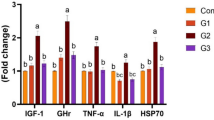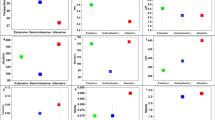Abstract
A recrystallized solvate of enrofloxacin in the form of hydrochloride dihydrate (enro-C) has shown a greater bioavailability in other species and a higher solubility in water compared to standard enrofloxacin. This led to define the pharmacokinetics (PK) of enro-C in tilapia (Oreochromis niloticus × Oreochromis mossambicus), when administered as in-feed medication, either by the addition of enro-C during food pelleting (T2) or by the coating of pre-manufactured pellets with a gelatin suspension containing enro-C (T1). T1 and T2 were both prepared with 3000 mg of enro-C/kg of feed, and a total dose of 10 mg/kg based on feed consumption. The trial was carried out in fresh water tanks, collecting blood samples twelve times during 70 h (three repetitions with five tilapias per sampling time). Maximum plasma concentrations (CMAX) for T1 and T2 were 1.35 ± 0.55 μg/mL and 1.92 ± 0.26 μg/mL, respectively. The time to achieve CMAX (TMAX) occurred almost simultaneously at 6.5 h. The area under the plasma vs time concentrations (AUC0-24) were 25.41 ± 24 μg/mL/h and 57.91 ± 30 μg/mL/h for T1 and T2, respectively. MIC data from available literature indicate that PK/PD ratios (CMAX/MIC90 and AUC0-24/MIC90) are higher in T2 compared to T1 in tilapia. Results indicate that the customary dose of enrofloxacin (10 mg/kg) using enro-C reaches, in particular, higher values of CMAX and AUC0-24. Thus, based on these results, it is feasible to propose enro-C for the treatment of bacterial diseases in tilapia, preferably as was done in T2. However, before this happens, toxicity and drug-residue studies, as well as environmental and public health issues, must be resolved.

Similar content being viewed by others
Notes
Ministry of Agriculture, Livestock, Rural Development, Fisheries and Food (SAGARPA). Official Mexican Standard (NOM-062-ZOO-1999), [cited 2018 January 30]. Available from: http://www.fmvz.unam.mx/fmvz/principal/archivos/062ZOO.PDF
References
Alderman DJ, Hastings TS (1998) Antibiotic use in aquaculture: development of antibiotic resistance – potential for consumer health risks. Int J Food Sci Technol 33:139–155. https://doi.org/10.1046/j.1365-2621.1998.3320139.x
Austin B, Austin DA (2007) Bacterial fish pathogens. Disease of farmed and wild fish. Dobbins P, Ed. (4th ed.). Springer, Chichester
Bennett JV, Brodie JL, Benner EJ, Kirby WM (1966) Simplified, accurate method for antibiotic assay of clinical specimens. Appl Microbiol 14(2) 170–177 Retrieved from http://www.ncbi.nlm.nih.gov/pubmed/4959982%5Cn http://www.pubmedcentral.nih.gov/articlerender.fcgi?artid=PMC546645. Accessed Oct 2018
Botelho RG, Christofoletti CA, Correia JE, Ansoar Y, Olinda RA, Tornisielo VL (2015) Genotoxic responses of juvenile tilapia (Oreochromis niloticus) exposed to florfenicol and oxytetracycline. Chemosphere 132:206–212. https://doi.org/10.1016/j.chemosphere.2015.02.053
Bowser PR, Babish JG (1991) Clinical pharmacology and efficacy of fluoroquinolones in fish. Annual Review of Fish Diseases, 1(C), 63–66. https://doi.org/10.1016/0959-8030(91)90022-C
Carrascosa A, Gutierrez L, De la Peña A et al (2017) Efficacy of a new recrystallized enrofloxacin hydrochloride-dihydrate against leptospirosis in a hamster model. Antimicrob Agents Chemeoterp 61(11):1–10. https://doi.org/10.1128/AAC.01285-17
Chien Y 2009 “Novel Drug Delivery Systems.” In J Neurosci Nurs, edited by James Swarbrick, 2nd ed., 14:139–96. Chapel Hill, North Carlina. https://doi.org/10.1097/JNN.0b013e318193458b
El-Sayed, AFM (2006) Tilapia culture. Wallingford, Oxfordshire. https://doi.org/10.1079/9780851990149.0000
Fais AP, Scrapino R, Blado AF et al (2017) LC-MS/MS methods for sulfadimethoxine and ormetoprim analysis in feed and fish fillet and a leaching study for feed after alternative procedures for the incorporation of drugs. Food Addit Contam B 34(4):501–508. https://doi.org/10.1080/19440049.2016.1267875
FAO (2016) The State of World Fisheries and Aquaculture 2016. Contributing to food security and nutrition for all. Rome. http://www.fao.org/3/a-i5555e.pdf Cited 20 Jan 2017
Gutierrez L, Miranda-Calderon JE, Garcia-Gutierrez P, Sumano H (2015) Physicochemical characterization and pharmacokinetics in broiler chickens of a new recrystallized enrofloxacin hydrochloride dihydrate. J Vet Pharmacol Ther 38(2):183–189. https://doi.org/10.1111/jvp.12153
Idowu OR, Peggins JO (2004) Rapid determination of enrofloxacin and ciprofloxacin in bovine milk and plasma by high-performance liquid chromatography with fluorescence detection. J Pharm Biomed Anal 35:143–153. https://doi.org/10.1016/j.jpba.2004.01.006
Inglis V, Richards RH (1991) The in vitro susceptibility of Aeromonas salmonicida and other fish pathogenic bacteria to 29 antimicrobial agents. J Fish Dis 14(6):641–650. https://doi.org/10.1111/j.1365-2761.1991.tb00622.x
Jimenez R (2007) Enfermedades de Tilapia en Cultivo (Tilapia disaeses in culture). Guayaquil
Meyer F (1989) Solutions to the shortage of approved fish therapeutants. J Aquat Anim Health 1:78–80
Miranda-Calderón JE, Gutiérrez L, Flores-Alamo M, García-Gutiérrez P, Sumano H (2014) Enrofloxacin hydrochloride dihydrate. Acta Crystallogr E: Struct Rep Online 70(4):o468–o469. https://doi.org/10.1107/S1600536814006059
Noga EJ. (2010) Fish disease: diagnosis and treatment, Second Edition. Ames, Iowa. https://doi.org/10.1002/9781118786758
Oyebanji M, Omoregie E (2002) Oxytetracycline-induced blood disorder in juvenile Nile tilapia. J Worls Aquacult Soc 33(3):0–5. https://doi.org/10.1111/j.1749-7345.2002.tb00514.x
Rey A, Iregui C, Verján N (2002) Diagnóstico clínico patológico de brotes de enfermedad en tilapia roja (Oreochromis spp). Pdf. Rev Med Vet Zoot 49(13–21):9
Riche M, Haley DI, Oetker M, Garbrecht S, Garling DL (2004) Effect of feeding frequency on gastric evacuation and the return of appetite in tilapia Oreochromis niloticus (L.). Aquaculture 234(1–4):657–673. https://doi.org/10.1016/j.aquaculture.2003.12.012
Rucinque DS, Polo G, Borbón J et al (2016) Anesthetic use of eugenol and benzocaine in juveniles of red tilapia. Rev Colom Cienc Pec 60(57):60–66. https://doi.org/10.17533/udea.rccp.v30n1a07
SAGARPA (2017) Avanza México como una potencia en producción acuícola (Mexico advances as a power in aquaculture production) (Vol. BCS/135/20). Mexico City. Retrieved from https://www.gob.mx/sagarpa/prensa/avanza-mexico-como-una-potencia-en-produccion-acuicola Cited 20 Jan 2018. Accessed Oct 2018
Soto-Rodríguez S, Armenta M, Gomez-Gil B (2006) Effects of enrofloxacin and florfenicol on survival and bacterial population in an experimental infection with luminescent Vibrio campbellii in shrimp larvae of Litopenaeus vannamei. Aquaculture 255(1–4):48–54. https://doi.org/10.1016/j.aquaculture.2005.11.035
Souza ME, Bittencourt C, Souza PS (2004) Microbiological assay for enrofloxacin injection. Int J Pharm 271(1–2):287–291. https://doi.org/10.1016/j.ijpharm.2003.11.012
Subasinghe R, Soto D, Jia J (2009) Global aquaculture and its role in sustainable development. Reviews in Aquaculture 1(1):2–9. https://doi.org/10.1111/j.1753-5131.2008.01002.x
Sumano H, Ocampo L, Gutierrez L (2018) Comparative pharmacokinetics of a new solvate of enrofloxacin as HCl-2H2O (enro-c) in dogs and PK/PD simulations against Leptospira spp. J Vet Sci 19(5):600–607. https://doi.org/10.4142/jvs.2018.19.5.600
Tang J, Yang X, Zheng Z, Yu WJ, Hu K, Yu HJ (2006) Pharmacokinetics and the active metabolite of enrofloxacin in Chinese mitten-handed crab (Eriocheir sinensis). Aquaculture 260(2006):69–76. https://doi.org/10.1016/j.aquaculture.2006.05.036
Teles JA, Castello Branco LC, Bianchi D et al (2016) Pharmacokinetic study of enrofloxacin in Nile tilapia (Oreochromis niloticus) after a single oral administration in medicated feed. J Vet Pharmacol Ther 39(2):6–9. https://doi.org/10.1111/jvp.12257
Udomkusonsri P, Arthitvong S, Klangkaew N et al (2007) Pharmacokinetics of enrofloxacin in Koi carp (Cyprinus carpio) after various routes of administration. Kasetsart J. (Nat. Sci.) 41:62–68
United States Food and Drug Administration (2015) Freedom of information summary (Vol. 30). Silver Spring, Washington DC. Retrieved from https://animaldrugsatfda.fda.gov/adafda/app/search/public/document/downloadFoi/385 Cited 32 Jul 2018. Accessed Oct 2018
Uscanga A, Moyano FJ, Alvarez CA (2010) Assessment of enzymatic efficiency on protein digestion in the tilapia Oreochromis niloticus. Fish Physiol Biochem 36(4):1079–1085. https://doi.org/10.1007/s10695-010-9385-8
Woo PTK, Leatherland JF, Bruno WD (2011) Book Review: Fish diseases and disorders. Volume 3: Viral, bacterial and fungal infections. Second Edition. Q Rev Biol 82:69. https://doi.org/10.1086/513384
Zaki MM, Eissa AE, Saeid S (2011) Assessment of the immune status in Nile tilapia (Oreochromis niloticus) experimentally challenged with toxogenic/septicemic bacteria during treatment trial with florfenicol andenrofloxacin. WJFMS 3(1): 21–36
Acknowledgments
The authors are grateful for the skillful definition of the new crystal form of enrofloxacin (enro-C) carried out at The School of Chemistry, Trinity College; Dublin, Republic of Ireland.
Funding
This project was partially supported by CONACyT, project No. 203.
Author information
Authors and Affiliations
Corresponding author
Ethics declarations
Conflict of interest
Authors have no conflict of interests. The National Autonomous University of Mexico (UNAM), owner of the patent, is open to licensing of enro-C.
Ethical approval
All applicable international, national, and institutional guidelines for the care and use of animals were followed by the authors.
Additional information
Publisher’s note
Springer Nature remains neutral with regard to jurisdictional claims in published maps and institutional affiliations.
Rights and permissions
About this article
Cite this article
Estrada-San Agustín, E., Gutiérrez, L., Bernad, M. et al. Pharmacokinetics of two dosing forms of a recrystallized enrofloxacin as hydrochloride dihydrate in tilapia (Oreochromis niloticus × Oreochromis mossambicus). Aquacult Int 27, 849–857 (2019). https://doi.org/10.1007/s10499-019-00371-9
Received:
Accepted:
Published:
Issue Date:
DOI: https://doi.org/10.1007/s10499-019-00371-9




